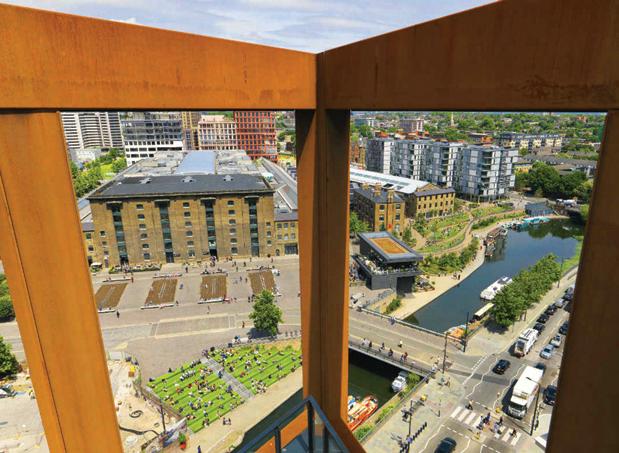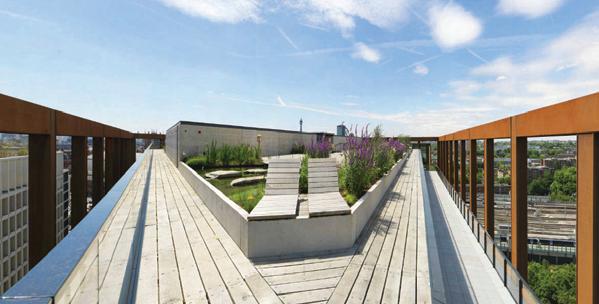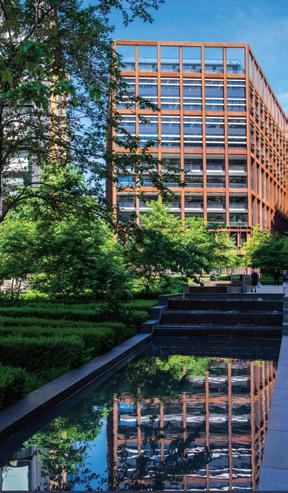
8 minute read
Universal Music at Kings Cross
Sounds good
Universal Music has moved in to one of the many creative spaces being designed as part of the redevelopment of Kings Cross. Nicky Roger covers the story.
Advertisement
GEZE’s automatic doors have hit just the right note in the development of a London building which is the new home of Universal Music.
Two automatic circular sliding doors create an entrance to 4 Pancras Square – one of a cluster of new buildings that have led to the emergence of Kings Cross as a creative hub.
They are a statement piece to the 11-storey angular building which reflects the area’s lineage as a former goods yard to King’s Cross railway. With an exposed weathered steel frame, the Eric Parry Architects building echoes the industrial revolution which enabled the expansion of London.
Positioned side by side, the two Slimdrive SCRs provide a 360° drive solution combining high performance with unobtrusive operation – the drives are just 7 cm in height and very discreet – and as pass doors are not needed, they maintain the clean aesthetics of the glazed facade.
Focchi undertook the installation of the façade: glazing, entrance and building envelope and worked with GEZE UK to identify the right
solution – moving away from an original design featuring revolving doors which would have prompted requirements for pass doors.
There are also environmental benefits to the Slimdrive SCR selection – having only one set of doors open at a time, reduces heat loss and air pollution. Emergency buttons on reception were also added to immediately close the doors and prohibit the building being surged by fans in the wake of a visiting celebrity! There is also bespoke lettering in the canopy of the Slimdrive SCR which was laser cut by GEZE UK and bespoke bronze lettering was added. Other GEZE products used around the building include a Slimdrive SL NT automatic sliding door with access control. This allows workers to access a cycle ramp, meaning that they can ride straight up to a cycle store – part of the solution to reduce carbon footprint.
The Slimdrive SL NT is a good solution for buildings with high levels of footfall and a continuous flow of people moving in various directions. Almost invisible, it is virtually silent in operation and can move leaf weights of up to 125kg.
The Kings Cross redevelopment site is the perfect mix of grittiness and shininess, simultaneously a symbol of London’s industrial and engineering past and the creative present.” Edwin Heathcote, Financial Times

4 Pancras Square, the new home of Universal Music, won a RIBA regional award for its design and has incorporated GEZE door technology. The square is part of a wider redevelopment of Kings Cross, transforming it into a creative destination
In addition, there are eight pairs of TS 550 floor springs fitted to retail units within the building. This provides an option to automate the entrances in the future – effectively ‘future proofing’ them. Extensive rooftop gardens were added to the office block, which were intended to evoke a ‘windswept moorland’ and provide a peaceful oasis in the midst of the city with panoramic views across London. The relocation puts Universal among a vibrant set of neighbours, including Google, global media company Havas, Louis Vuitton and PRS, as well as Central Saint Martins, the world’s leading fashion college. Eric Parry architects won a RIBA regional (London) award for the building. The judges said the practice had “skillfully composed and crafted a handsome ‘stop end’ to what might have been an awkward triangular park which rises up towards it. What could have been a clumsy wedge-shaped commercial building sits very comfortably on the complicated slopes of this site. The change of external levels on the northern facade which fronts a steep road gradient on Goods Way has also been handled with expertise.” The design was also praised for evoking the old industrial heritage of the site, which used to house


67 acres 50 new buildings 1 , 900 new homes 20 new streets 10 new public parks and squares 26 acres of open space 30 , 000 people by 2016 King’s Cross in numbers
Above: Pancras Square aerial view with 4 Pancras Square’s unusual shape clearly visible. Right: the rooftop garden of 4 Pancras Square
gasometers and adjoins the railway, in the choice of exposed weathering steel for its structural exo-skeleton, providing “a convincing narrative for the muscularity of the predominant material which exudes character and imbues the new square with a robust anchor”.
In a contemporary updating of Victorian engineering, a key feature of the steelwork is a Vierendeel truss encircling the first floor of the building which has created a huge, uninterrupted space at ground level facing into Pancras Square. With its heavily riveted connection plates, the grittiness of the past industrial architecture is expressed.
It is heartening to see the current market emphasis on sustainability and well-being so deftly delivered; BREEAM Outstanding certification, external amenity space for each floor, all crowned by an expansive and crafted rooftop garden landscape complete with ponds and boulders. From this vantage point, created in an earlier phase of this vast regeneration project, the 1000+ staff at Universal

Music can watch the latest pieces of the King’s Cross regeneration jigsaw being put into place. In turn this finely proportioned new building contributes significantly as a central architectural landmark to the distinctive character of this bold regeneration project. BAM, the principal constructor, describes the building as “epitomising the regeneration of the area: a sympathetic fusion of old and new. But its deceptive simple form hides high-tech design features and award winning sustainability solutions”. The long-term redevelopment of the area North of London’s Kings Cross Station is one of the biggest and most impressive feats of regeneration in the capital’s history.
Sprawling across 67 acres, the site includes numerous historic buildings – many of them dramatically restored and repurposed for the C21 – as well as new constructions that have to sit comfortably alongside the old, while avoiding pastiche and visual clichés. Within the first few years of its life, the building’s corten

Kings Cross: new postcode, new destination The rebirth of the wasteland around the station has been a long process

The rusty exo-skeleton of 4 Pancras Square reflected in pools at the centre of the square
steel exo-skeleton will weather to a mellow, rusty texture.
Four Pancras Square has stunning views across Regent’s Canal to Granary Square and St Pancras Clock Tower. The building provides 170,000 sq ft of office accommodation over 10 floors, with retail at street level and basements below. Its imposing structure dominates Pancras Square, reflected in the cascading pools at the heart of this part of the redevelopment. The top floor features a rooftop garden with a landscaped terrace, planting beds and water features.
Universal Music’s move to Kings Cross, one of the fastest growing creative corners of the capital, means leaving behind its old home in London’s former music business mecca, Kensington.
David Joseph, chair and CEO of Universal Music UK, says: “Kings Cross is fast emerging as a creative hub for London. It’s going to be an energising place to work and feels like a natural home for Universal Music with many opportunities for collaboration and inspiration literally on our doorstep.” n
Kings Cross is one of the largest and most drastic redevelopments in London. What was an underused industrial wasteland is being transformed into a new part of the city with homes, shops, offices, galleries, bars, restaurants, schools, and even a university. It’s a whole new piece of London with a brand new postcode, N1C.
The 67-acre site has a rich history and a unique canal side setting. In Victorian times, King’s Cross was an important industrial heartland. But by the late 20th Century, the area known as the railway lands had become a series of disused buildings, railway sidings, warehouses and contaminated land. Early plans for redevelopment fell through, but the 1996 decision to move the Channel Tunnel Rail Link from Waterloo to St Pancras became the catalyst for change. The landowners – London & Continental Railways Limited and Excel (now DHL) decided to develop the land.
In 2001, Argent was selected as the development partner. The project began with several years of intensive studies and consultation with the local community, government and other stakeholders. This work formed the basis for a vision for the development, from which the masterplan evolved.
The plan was prepared by Allies and Morrison, Porphyrios Associates and Townshend Landscape Architects, in 2006 outline planning permission was granted. The permission allows for c.50 new building, 20 new streets, 10 new major public spaces, the restoration and refurbishment of 20 historic buildings and structures and up to 2,000 homes.
In 2008, Argent, London & Continental Railways and DHL formed a joint partnership: Kings Cross Central Limited Partnership. The partnership was the single land owner at King’s Cross. Early infrastructure works began in June 2007, with development starting in earnest in November 2008.

Much of the early investment was focused in and around the Victorian buildings that once formed the Goods Yard.
In September 2011 the University of the Arts London moved to the Granary Complex and parts of the development opened to the public for the first time.
Since then, restaurants have opened, the Great Northern Hotel has been refurbished and re-opened and the first residents have moved in.
A whole series of new public squares and gardens have opened, among them Granary Square with its spectacular fountains, Lewis Cubitt Park and Square and the new Gasholder Park.
In January 2015, the UK government and DHL announced the sale of their investment in the King’s Cross redevelopment to Australian Super, Australia’s biggest superannuation/ pension funds. King’s Cross is its first direct London investment and only its second in the UK.











